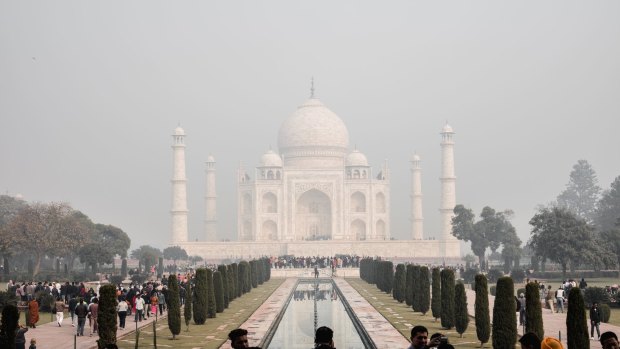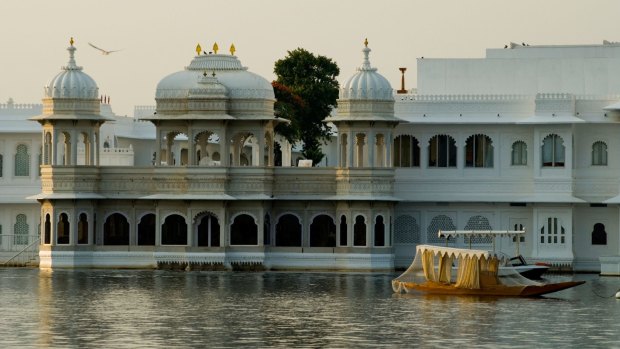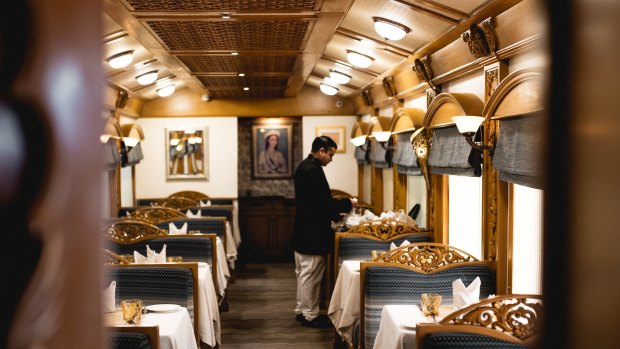This was published 5 years ago
Travelling through India on the Deccan Odyssey luxury train: Why you should experience five-star luxury in Rajasthan
One of the greatest feelings in travel, surely, is the one you get from doing it the fancy way for the first time. The first time you sleep in a boutique hotel rather than a hostel, the first time you fly business instead of economy, the first time you shirk the Maggi noodles for the hatted restaurant. Which is why today, the first day I've travelled by luxury train in India, feels so terrific. After years of being sardined into the cheap seats of the country's public rail network, I feel this is what I truly deserve.
It's the first evening of our seven-night APT journey on The Deccan Odyssey, a luxury train inspired by the imperial carriages used by the Maharajahs, travelling from Mumbai on the west coast up to Delhi in the north. Having unpacked our suitcases and settled into our small but perfectly formed ensuite cabin, my husband and I sip cold glasses of Indian rosé in the bar car as the train click-clacks out of Mumbai. Once the sun has disappeared behind the hills, we shift to one of two dining cars, where our spicy vegetarian thalis are served on silver platters and accompanied by glasses of champagne. By the time we head back to our cabin, where our personal butler serves us tea in bed as we watch the night roll past our windows, I'm feeling every bit the Maharini I most certainly am not.

More than 30,000 people visit the Taj Mahal each day.Credit: Peter Windrim
Five years ago, as an innocent newcomer to India, I recall disembarking from a Rajasthani train journey and having my foot run over by a wooden cart laden with fresh fruit as I squeezed through the teeming crowds. This morning, thank goodness, it's a disembarkation of a very different kind. As we alight on a private, near-empty platform in Vadodara in the state of Gujarat, we're welcomed by turbaned musicians performing Indian classical music, and women who drape marigold garlands around our necks.
It's a perfectly fitting welcome, since we spend the morning exploring the UNESCO-listed Champaner Archaeological Park, filled with majestic palaces, mosques and temples dating as far back as the 8th century. As the day starts to fade we head to the Laxmi Vilas Palace, the world's largest private dwelling that remains the residence of the royal family, which is four times the size of Buckingham Palace. Regular travellers aren't allowed to enter the palace, but APT have organised access for us. Inside the sprawling central hall, with its Venetian mosaic floor and walls and Belgian-stained glass windows, we're showered with rose petals and treated to a local folk performance and high tea from the royal kitchen. It's the ultimate queenly experience, and one I could get very used to.
Anyone who has travelled in India knows that getting anywhere is usually an ordeal. Except, I'm now realising, if you're travelling by luxury train, and then it's like clockwork. The following morning we arrive on time in the princely city of Udaipur, which our local guide describes as "the most beautiful, romantic city in India". After a delicious breakfast of aloo paratha, Indian bread stuffed with mashed potato and spices, and sweet masala chai, we disembark and start exploring.

The famous Lake Palace Hotel in Udaipur, Rajasthan.Credit: Alamy
Udaipur is often referred to as the Venice of the East, and for good reason. It is cool, green and clean, surrounded by the Aravali ranges and set around shimmering Lake Pichola, on which the famous floating Lake Palace hotel sits. We spend some time exploring the opulent 16th-century hilltop City Palace, where the current royal family still live, then putter around the lake by boat, ogling the arched and domed sugar-white architecture lining the shore.
The real treat, though, awaits us back on-board The Deccan Odyssey. Our APT tour director tells us to gather in the bar car for a surprise, and minutes later we're joined by the Prince of Udaipur, Lakshyaraj Singh Mewar, accompanied by his wife and four-year-old daughter. In my imagination, the first time I met a Rajasthani prince he would be decked out in a turban and some sort of fabulous bejewelled robe. But Lakshyaraj is a modern prince, who arrives in chinos, a checked shirt and a zip-up Cricket Australia vest. In between telling us his thoughts on where India is headed politically, and about the 11 heritage hotels and numerous schools and charities he runs, he insists he is just a regular person. If I hadn't visited his palace earlier, and could ignore the grape-sized diamonds perched on his wife's fingers, I just might believe him.
When I last visited the Rajasthani city of Jodhpur, I found myself terribly lost in a tiny back alley with my parents, surrounded by a pack of snarling, rabid-looking street dogs from which we only narrowly escaped. Today's visit to the blue city, so named for its vivid powder-blue houses, is a much plusher affair. Our APT tour director is escorting us safely around the city, first through the bustle of the Old Clock Tower market where locals hawk fragrant spices, colourful lac bangles and bejewelled scarves as cows lumber casually past, then up to the ochre-coloured Mehrangarh Fort. Rudyard Kipling famously described the fort, built in 1460 and perched on a rocky hill above the city, as "the work of angels, fairies and giants". Seeing it in the flesh, it's easy to believe he meant it literally. It's one of India's most magnificent forts, and a traveller can easily lose an afternoon exploring the panoramic ramparts lined with antique artillery, the ancient art-filled museum and the lush 18th-century Chokelao Bagh garden. But the best way to experience this fort, I soon discover, is after dark.

The Deccan Odyssey is inspired by the imperial carriages used by the Maharajahs.Credit: Peter Windrim
As twilight sets in, we're escorted to a terrace at the foot of the fort, where dinner awaits. As we watch the fort get lit up above us and dig into a delicious Jodhpuri barbecue feast, a group of local musicians and dancers perform Jodhpur's renowned folk music, with its furious, possessed drumming. The flickering light from our candlelit tables catches the mirror work in the dancer's skirts, and I begin to wonder if this is all a dream.
The following morning The Deccan Odyssey deposits us in Agra, where we head out for a mid-morning visit to the Taj Mahal. When I last visited this wonder of the world, which welcomes about 30,000 visitors each day, the crowds smothering the white marble mausoleum bothered me so much I was unable to properly appreciate its beauty. This time around, the edge is taken off the selfie-seeking masses by the champagne lunch we're surprised with after our visit, at the nearby Taj Khema, an elevated garden with extraordinary crowd-free views over the Taj Mahal.
Our final surprise comes in the form of a private APT-hosted tour through Kohinoor Jewellers, a family-run gem store and museum that has been doing business in Agra since 1862. We're shown around the fascinating basement workshop where we watch rubies, sapphires and black diamonds being crafted into gold and silver jewellery by hand. Upstairs, I find myself slipping a square-cut emerald ring onto my middle finger, jiggling my hand to see it sparkle in the light. I can't help but laugh, with the realisation of just how remote this rail adventure has been from my last. India may specialise in intensity and chaos, but doing it this way – the fancy way – makes it easy to fall under the country's hypnotic spell.
TRIP NOTES
MORE
TOUR
APT's 17-day Spirit of India tour, which includes seven nights on The Deccan Odyssey, starts from $16,895 a person twin share, with a "fly free" offer if you book before February 28. See aptouring.com.au.
FLY
Singapore Airlines operates multiple daily flights between Sydney, Melbourne and Brisbane and Mumbai, via Singapore. See singaporeair.com
Nina Karnikowski travelled courtesy of APT
FIVE MORE THINGS TO DO IN RAJASTHAN
JAIPUR'S JANTAR MANTAR
If you see only one monument in Jaipur, let it be this UNESCO-protected observatory. It houses 19 super-sized astronomical instruments created 284 years ago by king Sawai Jai Singh II, including the world's largest stone sundial, at 27 metres tall.
DELHI MUST-EAT
Fantastic regional Indian food, in a chic space featuring fuchsia walls and vintage Bollywood music, Jamun is a Delhi must. Try their Goan fish curry and an alcoholic lassi.
RANTHAMBORE TIGERS
No Rajasthani journey is complete without a tiger safari in Ranthambore national park. If the tiger remains elusive, you'll still see Indian gazelle, antelopes, crocodiles and perhaps even sloth bears.
See ranthamborenationalpark.com
JODHPUR TEXTILES
Maharani Art Exporters in Jodhpur's main bazaar is a four-storey Aladdin's cave of Indian fabrics that wholesales to the likes of Kenzo and Hermès, and counts Madonna and Richard Gere as fans. Their ultra-soft cashmere wraps are particularly lovely.
AGRA FORT
Some say Agra Fort, the 16th-century red sandstone Mughal fortress overlooking the Taj Mahal gardens, is more impressive than the Taj itself. Whether or not you agree, it's certainly less crowded.
Sign up for the Traveller Deals newsletter
Get exclusive travel deals delivered straight to your inbox. Sign up now.